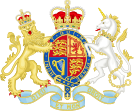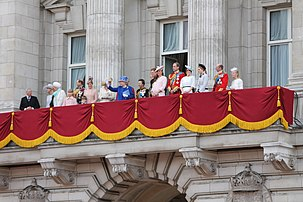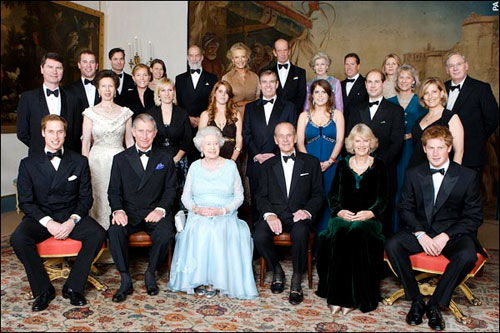The British Royal Families
http://www.cannabis-seeds-store.co.uk/redebose-0-3-5.html
Carolinashoe.com Men's Steel Toe Boots
British royal family
(Redirected from Royal Family of United Kingdom)
Jump to navigationJump to search
| showRoyal family of the United Kingdom and the other Commonwealth realms |
|---|
| United Kingdom politics |
|---|
| This article is part of a series on |
 |
The British royal family comprises Queen Elizabeth II and her close relations. There is no strict legal or formal definition of who is or is not a member of the British royal family.
Those who at the time are entitled to the style His or Her Royal Highness (HRH), and any styled His or Her Majesty (HM), are normally considered members, including those so styled before the beginning of the current monarch's reign. By this criterion, a list of the current royal family will usually include the monarch, the children and male-line grandchildren of the monarch and previous monarchs, the children of the eldest son of the Prince of Wales, and all of their current or widowed spouses.
Some members of the royal family have official residences named as the places from which announcements are made in the Court Circular about official engagements they have carried out. The state duties and staff of some members of the royal family are funded from a parliamentary annuity, the amount of which is fully refunded by the Queen to the Treasury.[1]
Since 1917, when King George V changed the name of the royal house from Saxe-Coburg and Gotha, members of the royal family have belonged, either by birth or by marriage, to the House of Windsor. Senior titled members of the royal family do not usually use a surname, although since 1960 Mountbatten-Windsor, incorporating Prince Philip's adopted surname of Mountbatten, has been prescribed as a surname for Elizabeth II's direct descendants who do not have royal styles and titles, and it has sometimes been used when required for those who do have such titles. The royal family are regarded as British cultural icons, with young adults from abroad naming the family among a group of people that they most associated with British culture.[2]
Contents
- 1Status
- 2Public role
- 3Current members
- 4In other Commonwealth realms
- 5See also
- 6Notes
- 7References
- 8Further reading
- 9External links
Status[edit]
On 30 November 1917, King George V issued letters patent defining the styles and titles of members of the royal family; the text of the notice from the London Gazette is:[3]
Whitehall, 11th December, 1917.
- The KING has been pleased by Letters Patent under the Great Seal of the United Kingdom of Great Britain and Ireland, bearing date the 30th ultimo, to define the styles and titles to be borne henceforth by members of the royal family. It is declared by the Letters Patent that the children of any Sovereign of the United Kingdom and the children of the sons of any such Sovereign and the eldest living son of the eldest son of the Prince of Wales shall have and at all times hold and enjoy the style, title or attribute of Royal Highness with their titular dignity of Prince or Princess prefixed to their respective Christian names or with their other titles of honour; that save as aforesaid the titles of Royal Highness, Highness or Serene Highness, and the titular dignity of Prince and Princess shall cease except those titles already granted and remaining unrevoked; and that the grandchildren of the sons of any such Sovereign in the direct male line (save only the eldest living son of the eldest son of the Prince of Wales) shall have the style and title enjoyed by the children of Dukes.
In 1996, Queen Elizabeth II modified these letters patent, and this Notice appeared in the London Gazette:[4]
The QUEEN has been pleased by Letters Patent under the Great Seal of the Realm dated 21st August 1996, to declare that a former wife (other than a widow until she shall remarry) of a son of a Sovereign of these Realms, of a son of a son of a Sovereign and of the eldest living son of the eldest son of The Prince of Wales shall not be entitled to hold and enjoy the style, title or attribute of Royal Highness.
On 31 December 2012, letters patent were issued to extend a title and a style borne by members of the royal family to additional persons to be born, and this Notice appeared in the London Gazette:[5]
The QUEEN has been pleased by Letters Patent under the Great Seal of the Realm dated 31 December 2012 to declare that all the children of the eldest son of The Prince of Wales should have and enjoy the style, title and attribute of Royal Highness with the titular dignity of Prince or Princess prefixed to their Christian names or with such other titles of honour.
Members and relatives of the British royal family historically represented the monarch in various places throughout the British Empire, sometimes for extended periods as viceroys, or for specific ceremonies or events. Today, they often perform ceremonial and social duties throughout the United Kingdom and abroad on behalf of the United Kingdom. Aside from the monarch, their only constitutional role in the affairs of government is to serve, if eligible and when appointed by letters patent, as a Counsellor of State, two or more of whom exercise the authority of the Crown (within stipulated limits) if the monarch is indisposed or abroad. In the other countries of the Commonwealth royalty do not serve as Counsellors of State, although they may perform ceremonial and social duties on behalf of individual states or the organisation.
The Queen, her consort, her children and grandchildren, as well as all former sovereigns' children and grandchildren, hold places in the first sections of the official orders of precedence in England and Wales, Scotland, and Northern Ireland. Wives of the said enjoy their husbands' precedence, and husbands of princesses are unofficially but habitually placed with their wives as well. However, the Queen changed the private order of precedence in the royal family in favour of Princesses Anne and Alexandra, who henceforth take private precedence over the Duchess of Cornwall, who is otherwise the realm's highest ranking woman after the Queen herself.[6][7] She did not alter the relative precedence of other born-princesses, such as the daughters of her younger sons.
Public role[edit]
The British royal family support Queen Elizabeth II in her state and national duties. Each year the family "carries out over 2,000 official engagements throughout the UK and worldwide".[8] Engagements include state funerals, national festivities, garden parties, receptions, and visits to the Armed Forces.[8]
Given the British royal family's public role and activities, it is sometimes referred to by courtiers as "The Firm",[9][10] a term attributed to Prince Philip, Duke of Edinburgh.[11][12]
Members of the royal family have started their own individual charities. Prince Charles started The Prince's Trust, which helps young people in the UK that are disadvantaged.[13] The Princess Royal started The Princess Royal Trust for Carers, which helps unpaid carers, giving them emotional support and information about benefit claims and disability aids.[14]
Current members[edit]
See also: List of members of the House of Windsor The royal family on the balcony of Buckingham Palace after the annual Trooping the Colour in 2013
The royal family on the balcony of Buckingham Palace after the annual Trooping the Colour in 2013As of 2020, members of the royal family are:
- Queen Elizabeth II and Prince Philip, Duke of Edinburgh (the monarch and her husband)
- Charles, Prince of Wales and Camilla, Duchess of Cornwall[a] (the Queen's son and daughter-in-law)
- Prince William, Duke of Cambridge and Catherine, Duchess of Cambridge (the Queen's grandson and granddaughter-in-law)
- Prince George of Cambridge (the Queen's great-grandson)
- Princess Charlotte of Cambridge (the Queen's great-granddaughter)
- Prince Louis of Cambridge (the Queen's great-grandson)
- Prince Harry, Duke of Sussex and Meghan, Duchess of Sussex (the Queen's grandson and granddaughter-in-law)[b]
- Prince William, Duke of Cambridge and Catherine, Duchess of Cambridge (the Queen's grandson and granddaughter-in-law)
- Anne, Princess Royal (the Queen's daughter)
- Prince Andrew, Duke of York (the Queen's son)
- Princess Beatrice (the Queen's granddaughter)
- Princess Eugenie (the Queen's granddaughter)
- Prince Edward, Earl of Wessex and Sophie, Countess of Wessex (the Queen's son and daughter-in-law)
- Charles, Prince of Wales and Camilla, Duchess of Cornwall[a] (the Queen's son and daughter-in-law)
- Prince Richard, Duke of Gloucester and Birgitte, Duchess of Gloucester (the Queen's cousin and cousin-in-law)
- Prince Edward, Duke of Kent and Katharine, Duchess of Kent (the Queen's cousin and cousin-in-law)
- Princess Alexandra, The Honourable Lady Ogilvy (the Queen's cousin)
- Prince Michael of Kent and Princess Michael of Kent (the Queen's cousin and cousin-in-law)
Relatives not using a royal style[edit]
Some close relatives of the Queen use no royal style but sometimes appear in listings:[15][16]
- Archie Mountbatten-Windsor (the Queen's great-grandson)
- Vice Admiral Sir Timothy Laurence (the Queen's son-in-law)
- Peter and Autumn Phillips (the Queen's grandson and granddaughter-in-law)
- Savannah Phillips (the Queen's great-granddaughter)
- Isla Phillips (the Queen's great-granddaughter)
- Zara and Michael Tindall (the Queen's granddaughter and grandson-in-law)
- Mia Tindall (the Queen's great-granddaughter)
- Lena Tindall (the Queen's great-granddaughter)
- Peter and Autumn Phillips (the Queen's grandson and granddaughter-in-law)
- Edoardo Mapelli Mozzi (the Queen's grandson-in-law)
- Jack Brooksbank (the Queen's grandson-in-law)
- Lady Louise Mountbatten-Windsor (the Queen's granddaughter)
- Viscount Severn (the Queen's grandson)[c]
- The Earl and Countess of Snowdon (the Queen's nephew and niece-in-law)
- Viscount Linley (the Queen's great-nephew)
- Lady Margarita Armstrong-Jones (the Queen's great-niece)
- Lady Sarah and Daniel Chatto (the Queen's niece and nephew-in-law)
- Samuel Chatto (the Queen's great-nephew)
- Arthur Chatto (the Queen's great-nephew)
- Sarah, Duchess of York (the Queen's former daughter-in-law)
The Duke and Duchess of Sussex (the Queen's grandson and granddaughter-in-law) have agreed to stop using a royal style in public, though they are still entitled to use it and have not formally relinquished it.[18][19] Viscount Severn and Lady Louise Mountbatten-Windsor fit the definition of the Letters Patent of 1917 and would be expected to have the title His or Her Royal Highness but, by agreement between the Queen and their father the Earl of Wessex, they do not use these styles.


